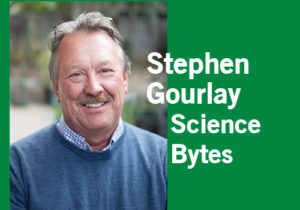Exploring the antimatter mystery
 Last month, I introduced you to the four fundamental forces found in nature. Three of them – the strong, weak and electromagnetic forces – are the foundation of the Standard Model in particle physics.
Last month, I introduced you to the four fundamental forces found in nature. Three of them – the strong, weak and electromagnetic forces – are the foundation of the Standard Model in particle physics.
The model classifies all known elementary particles and describes how they interact through the three forces. Developed over the last half century, it has been quite a success. It predicted the existence of quarks that make up the protons and neutrons that, in turn, make up the nuclei at the heart of atoms. We now know that there are six quarks that combine in various ways to make up a literal zoo of elementary particles.
Though quite comprehensive, the Standard Model has a few holes in it. For one, we haven’t figured out how gravity fits in the model yet. A Grand Unified Theory, which would include gravity, has yet to be discovered.
In my first article, I described the Scientific Method and how scientists create a simple model and then, based on observation and experiment, modify it. In the simplest model of particles one can think of, they have no mass. (Mass is how much stuff something has and is fundamental.)
Well, you don’t need to be a physicist to know that having no mass is wrong. After a lot of work, physicists came up with something called the Higgs mechanism that could explain how particles have mass. It is named after Peter Higgs, one of the physicists who proposed the idea.
This mechanism is embodied in a particle called the Higgs boson, which was subsequently discovered nine years ago at the Large Hadron Collider in Geneva.
Antimatter
Now to another missing piece of the puzzle and this month’s topic: The Standard Model encompasses the existence of antimatter. We now know that every particle has an antiparticle partner that shares the same mass, but characteristics such as electric charge are opposite.
For example, a proton has a charge of +1 and an antiproton a charge of -1. The existence of an antielectron, or positron, was mathematically predicted in 1928 by P.A.M. Dirac and subsequently discovered in 1932 by Carl Anderson.
Since then, beams of positrons and antiprotons have been generated by particle accelerators to study their interactions with matter. What happens when matter and antimatter come together? They annihilate in a burst of pure energy. Not at all compatible.
The problem is that the Standard Model predicts that matter and antimatter should be produced in exactly equal amounts. If this were true, then the Big Bang would have been a Big Fizzle producing nothing but energy.
Somehow, a tiny fraction of matter survived and became the universe we observe today. Several experiments have revealed a slight imbalance between matter and antimatter, but we don’t know why. It remains one of the biggest mysteries of particle physics.
Hospitals and homes
Antimatter is not just a product of the Big Bang and particle accelerators. Positron-emitting isotopes are used in medical imaging as the basis of Positron Emission Tomography (PET).
Antimatter can also be found in your own home. Positrons are produced naturally in the radioactive decay of certain elements. (Remember the Weak Force?) One form of potassium can become argon by emitting a positron. Your typical banana, which is rich in potassium, will emit a positron about once every 75 minutes.
For more details, visit quantumdiaries.org/2009/07/21/positrons-from-bananas/ or home.cern/science/physics/matter-antimatter-asymmetry-problem.
Steve Gourlay is a career scientist with a PhD in experimental particle physics. He recently retired after working at the Fermi National Accelerator Laboratory, CERN (the European Center for Nuclear Research) and the Lawrence Berkeley National Laboratory. Send questions and comments to him at sgpntz@outlook.com.

Steve Gourlay
Steve Gourlay is a career scientist with a PhD in experimental particle physics. He recently retired after working at the Fermi National Accelerator Laboratory, CERN (the European Center for Nuclear Research) and the Lawrence Berkeley National Laboratory. Send questions and comments to him at sgpntz@outlook.com.
